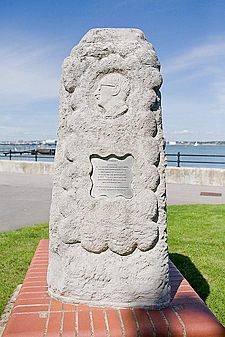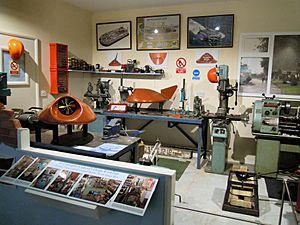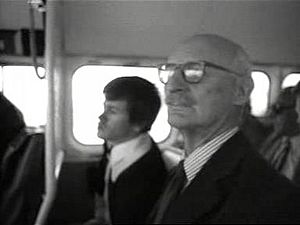Christopher Cockerell facts for kids
Quick facts for kids
Christopher Cockerell
|
|
|---|---|

Memorial to Cockerell at Hythe, Hampshire
|
|
| Born | 4 June 1910 'Wayside', Cavendish Avenue, Cambridge, England
|
| Died | 1 June 1999 (aged 88) Hythe, Hampshire, England
|
| Nationality | English |
| Citizenship | British |
| Alma mater | Peterhouse, Cambridge |
| Known for | Hovercraft |
| Awards | Fellow of the Royal Society RDI Elmer A. Sperry Award Royal Medal (1966) Albert Medal (1966) |
| Scientific career | |
| Fields | Mechanical Engineering |
Sir Christopher Sydney Cockerell (born June 4, 1910 – died June 1, 1999) was a brilliant English engineer. He is most famous for inventing the amazing hovercraft.
Contents
Early Life and School
Christopher Cockerell was born in Cambridge, England. His father, Sir Sydney Cockerell, was in charge of the Fitzwilliam Museum. His mother, Florence Kingsford Cockerell, was an artist and designer.
Christopher went to St Faith's School and then Gresham's School. He later studied mechanical engineering at Peterhouse, Cambridge University. He also went back to Cambridge to learn about radio and electronics.
Starting His Career
Christopher first worked for a company called W. H. Allen & Sons. After studying more about radio, he joined the Radio Research Company. In 1935, he started working at the Marconi Company.
He married Margaret Elinor Belsham that same year. During his time at Marconi, he led a team that worked on many important systems. This included radar, which helps detect objects using radio waves. After World War II, he helped develop equipment for the BBC at Alexandra Palace.
How the Hovercraft Was Born
After leaving Marconi, Christopher bought a small boat and caravan rental company. He wanted to make boats go faster. He knew that if a boat could be lifted out of the water, it would move much more easily. This idea led to his greatest invention: the hovercraft.
Cockerell realized that simply blowing air under a craft wasn't enough. He thought that if air was blown in a narrow jet around the edges, it would create a "momentum curtain." This curtain of moving air would trap a cushion of high-pressure air underneath. This meant a smaller engine could lift the craft completely out of the water.
He tested his ideas with simple things like a vacuum cleaner and two tin cans. His experiments showed that his idea could work! But it took many years to develop. He even had to sell some of his own belongings to pay for his research.
By 1955, he had built a working model out of balsa wood. He also filed his first patent for the hovercraft. But no private companies were interested in his idea. They thought it was too different from what they usually did.
So, he showed his idea to the British Government. He hoped they would see its use for defense. However, the government put his hovercraft design on a secret list. This meant Christopher couldn't tell anyone about his invention.
The hovercraft remained a secret until 1958. When similar ideas started appearing in other countries, the government finally made his design public. Christopher was then connected with the NRDC (National Research Development Corporation).
In 1958, the NRDC ordered the first full-sized hovercraft from Saunders-Roe. This first model was called the SR-N1. On June 11, 1959, the SR-N1 was shown to the public. It could carry four people at 28 miles per hour. Just weeks later, it made history by crossing the English Channel from Calais to Dover. This happened on July 25, 1959, exactly 50 years after the first airplane crossed the Channel!
In 1959, a company called Hovercraft Development Ltd. was formed. Christopher Cockerell became its Technical Director. This company managed the patents and allowed other firms to build hovercrafts.
Later in his life, Christopher continued to improve the hovercraft. He also invented other things that used the air cushion idea, like the hovertrain. He attended many events related to hovercrafts.
Sir Christopher Cockerell passed away on June 1, 1999, after a short illness.
Other Inventions
In his later years, Christopher Cockerell also developed something called the Cockerell Raft. This device uses the power of ocean waves to create electricity. It might be very important for generating power in the future.
Awards and Honors
Christopher Cockerell received many awards for his amazing work:
- 1965: He was given the Howard N. Potts Medal.
- 1966: He was made a Commander of the Order of the British Empire (CBE).
- 1967: He became a Fellow of the Royal Society, which is a very high honor for scientists.
- 1968: He won the Elmer A. Sperry Award for inventing the Hovercraft.
- 1969: He was made a Knight, which means he could use the title "Sir."
Remembering Christopher Cockerell

One of the large SR.N4 hovercrafts, called GH2008 Sir Christopher, was named after him. It carried passengers across the English Channel for many years.
There is a special plaque in East Cowes, Isle of Wight, where Christopher Cockerell used to live and work. His old workshop, including his special left-handed lathe, was given to the Lowestoft Maritime Museum after he died. It has been put back together there, so people can see where he worked.
Images for kids
See also
In Spanish: Christopher Cockerell para niños





